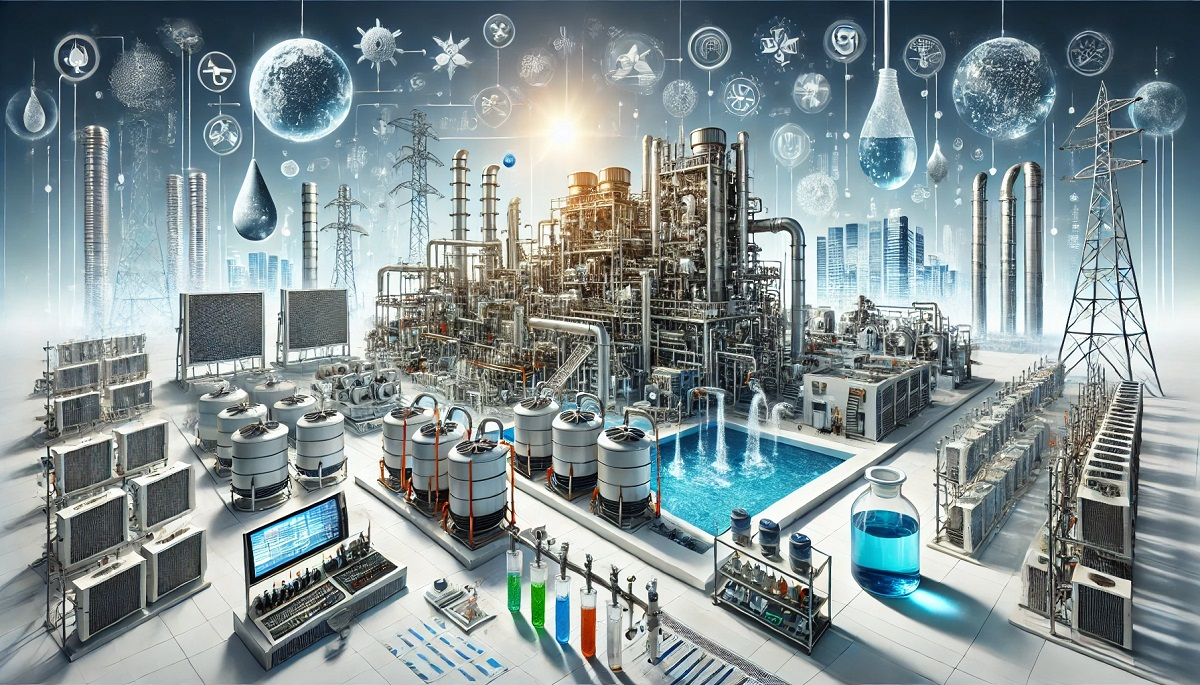The Cooling Water Treatment Chemicals Market by Type, Distribution Channel, End-User, and Region report by MarketDigits offers an in-depth analysis of the market landscape, focusing on key factors like product services, customer propositions, and key features.
It also explores the competitive index, highlighting major players and their strategic initiatives across various regions.
The forecast period from 2024 to 2032 provides valuable insights into emerging trends, market growth potential, and regional dynamics that shape the cooling water treatment chemicals industry.
The report aims to assist businesses in navigating the evolving market and identifying growth opportunities.
Get the Sample Research Report Copy on Cooling Water Treatment Chemicals Market: https://www.marketdigits.com/request/sample/4639
Rising Demand for Cooling Water Treatment Chemicals | Drivers and Future Projections
Key Drivers of Increased Demand
Expansion of the Power Industry: The power sector is the largest consumer of cooling water treatment chemicals. With thermal and nuclear power plants being major consumers of water for cooling purposes, the expansion of these plants globally has significantly contributed to the growth in demand for treatment chemicals.
Nuclear energy production increased by over 4% globally in 2021, reaching 2,653 TWh, and continued investment in nuclear energy projects worldwide is expected to drive further demand for cooling water treatment solutions.
Industrial Growth in Emerging Economies: Rapid industrialization in Asia-Pacific, particularly in emerging economies such as China, India, and Japan, has led to a marked increase in demand for cooling water treatment chemicals.
India’s power generation capacity reached approximately 400 GW by 2022, highlighting the growing need for cooling solutions that require water treatment chemicals for efficient operation.
The expansion of industrial facilities in these regions continues to support the upward demand trend.
Stricter Environmental Regulations: Governments worldwide have been implementing stricter environmental regulations concerning water usage, wastewater discharge, and sustainability in industrial processes.
To comply with these regulations, industries have increasingly adopted advanced cooling water treatment solutions, ensuring that water usage and discharge meet the environmental standards.
This has played a significant role in the increased consumption of water treatment chemicals in cooling systems.
Technological Advancements in Cooling Systems: The development of new, efficient, and sustainable cooling technologies has also spurred the demand for cooling water treatment chemicals.
Industries are continuously seeking solutions to optimize cooling system efficiency, enhance heat transfer, and increase the lifespan of equipment.
This demand for more sophisticated and effective cooling solutions has led to a rise in the consumption of specialty chemicals designed for advanced cooling systems.
Projected Increase in Demand in the Coming Years
Growing Water Scarcity Concerns: As global water scarcity intensifies, industries are being compelled to adopt water recycling and treatment solutions.
Water treatment chemicals will play a crucial role in ensuring sustainable water usage and helping industries reduce their reliance on freshwater sources.
This is expected to drive a continued increase in demand for cooling water treatment chemicals in the future.
Proliferation of Data Centers: The expansion of data centers, driven by the growth of digital infrastructure and the need for data storage, is poised to increase the demand for cooling solutions.
Data centers, which require substantial cooling to maintain optimal operating conditions, rely heavily on water treatment chemicals for the proper functioning of their cooling systems.
As the number of data centers grows, the demand for cooling water treatment chemicals is expected to rise.
Advancements in Water Treatment Technologies: Technological innovations in water treatment processes are expected to enhance the effectiveness and efficiency of cooling water systems.
With the development of more sophisticated water treatment solutions, industries will likely increase their reliance on these chemicals to meet the ever-evolving requirements of modern cooling systems.
This technological progress will drive the future demand for advanced cooling water treatment chemicals.
Top Innovations in Cooling Water Treatment Chemicals Market by Leading Companies (2024-2025)
1. Italmatch Chemicals: Smart-Tagged Polymers for Precision Monitoring
Italmatch Chemicals has pioneered the development of smart-tagged polymers designed for industrial water treatment. These advanced polymers incorporate embedded markers that enable real-time monitoring and control of polymer levels in water systems. The Lumiclene line of smart-tagged polymers helps optimize the use of chemicals by ensuring precise application, thus reducing waste and minimizing environmental impact. This innovation allows for greater efficiency, cost savings, and improved maintenance practices. By precisely managing the chemical dosage, the technology not only enhances cooling system performance but also reduces operational downtime and extends equipment longevity.
2. SUEZ: Advanced Desalination Technologies for Industrial Water Use
SUEZ, a leader in water treatment solutions, continues to set the standard for advanced desalination technologies. The company secured a significant contract in 2022 for the construction of a seawater reverse osmosis desalination plant in collaboration with Wanhua Chemical Group. This facility is designed to provide a reliable source of high-quality water for cooling and other industrial processes. SUEZ’s innovative desalination systems are crucial in addressing global water scarcity issues while ensuring industries have access to sustainable and cost-effective cooling water solutions. The company’s desalination technology offers enhanced water recovery, energy efficiency, and minimal environmental impact, making it an essential component of sustainable industrial operations.
3. Kemira: Sustainable Bio-Based Chemical Solutions
Kemira has made significant strides in developing bio-based chemicals for water treatment applications, focusing on sustainability and environmental responsibility. These bio-based solutions aim to reduce the ecological footprint of traditional water treatment processes without compromising performance. By utilizing renewable resources in the production of cooling water treatment chemicals, Kemira is helping industries reduce their reliance on fossil fuels and minimize harmful discharges into the environment. The company's bio-based chemicals are increasingly being adopted across industries as part of the broader trend toward more sustainable and eco-friendly practices in industrial operations. Kemira's continuous investment in R&D ensures that its solutions remain at the forefront of innovation in the water treatment sector.
4. Solenis: Multifunctional Chemical Formulations for Enhanced Performance
Solenis has introduced multifunctional chemical formulations designed to enhance the overall efficiency of cooling water treatment systems. These advanced formulations reduce the need for multiple chemical treatments, streamlining the water treatment process. By combining several functions into one product, Solenis’ formulations help simplify dosing procedures, reduce chemical consumption, and improve system performance. The innovative chemicals provide superior protection against scaling, corrosion, and biological fouling while maintaining high efficiency and performance standards. Solenis’ commitment to research and development ensures that these solutions are continually optimized to meet the evolving needs of industrial water treatment applications.
Get the complete view of 176 Pages Market Research Report on Cooling Water Treatment Chemicals: https://www.marketdigits.com/cooling-water-treatment-chemicals-market-1711539086
FAQs on Cooling Water Treatment Chemicals Market
What Chemicals Are Used in Cooling Water Systems?
Cooling water systems rely on various chemicals to maintain optimal performance, prevent issues such as scaling, corrosion, and biological growth, and ensure the longevity of the system. Some of the most commonly used chemicals include:
Corrosion and Scale Inhibitors: These chemicals prevent the formation of scale and protect metal components from corrosion. Products like ChemREADY's KOOL TOWER series are designed to prevent scale buildup and extend the lifespan of cooling systems.
Algaecides and Biocides: Algaecides are used to control the growth of algae and other microorganisms in cooling towers. Chemicals like those offered by ChemREADY help maintain system efficiency by preventing biological fouling.
pH Adjusters: Chemicals such as sodium hydroxide and sulfuric acid are commonly used to regulate the pH levels of cooling water, which helps optimize conditions for other treatment chemicals and prevents corrosion.
These chemicals collectively play a crucial role in ensuring the efficiency and environmental sustainability of cooling water systems.
What Are the Top 10 Water Treatment Chemicals?
Water treatment processes use a wide range of chemicals to ensure water quality, safety, and efficiency. The top 10 water treatment chemicals include:
Chlorine: A widely used disinfectant that effectively kills bacteria, viruses, and algae, ensuring safe water for industrial and domestic use.
Sodium Hypochlorite: Commonly known as liquid bleach, this chemical is used for disinfection and odor control in water systems.
Aluminum Sulfate (Alum): A coagulant that helps remove suspended solids from water, clarifying the water for further processing.
Lime (Calcium Oxide): Primarily used for pH adjustment and softening water by precipitating hardness-causing minerals.
Ferric Chloride: An effective coagulant for removing suspended solids and phosphorus from water, commonly used in industrial water treatment.
Sodium Bisulfite: This chemical is used for dechlorination, which removes residual chlorine from treated water, ensuring that the water is safe and ready for use.
Polymer Flocculants: These are used to aggregate fine particles into larger flocs, which can then be easily removed from water, improving water clarity.
Hydrogen Peroxide: A powerful oxidizing agent used for disinfection and removing organic contaminants from water.
Citric Acid: Often used for descaling and removing mineral deposits from equipment and systems, citric acid helps maintain the efficiency of water systems.
Phosphoric Acid: Used for pH adjustment and as a scale inhibitor, phosphoric acid is crucial in maintaining the optimal functioning of water treatment systems.
These chemicals play an essential role in the treatment of water, ensuring that it meets the required standards for various industrial, commercial, and domestic applications.
What Chemicals Are in Chilled Water Treatment?
Chilled water systems require specific chemicals to prevent scaling, corrosion, and biological growth. Some of the primary chemicals used in chilled water treatment include:
Corrosion Inhibitors: These chemicals are designed to protect metal components in the cooling system from corrosion, thus enhancing system performance and prolonging its lifespan.
Scale Inhibitors: These chemicals prevent the formation of scale deposits on heat exchange surfaces, which can reduce system efficiency and lead to costly repairs.
Biocides: Biocides control microbial growth in chilled water systems, including bacteria and algae, to maintain system efficiency and prevent fouling.
pH Adjusters: These chemicals are used to maintain optimal pH levels in the water, ensuring the effectiveness of other treatment chemicals and protecting the system from corrosion.
Other Trending Reports
CBD Oil Extract Market: https://www.marketdigits.com/cbd-oil-extract-market
Nanocellulose Market: https://www.marketdigits.com/nanocellulose-market
Hi-Tech Paints and Coatings for Autonomous Vehicles Market: https://www.marketdigits.com/hi-tech-paints-and-coatings-for-autonomous-vehicles-market



